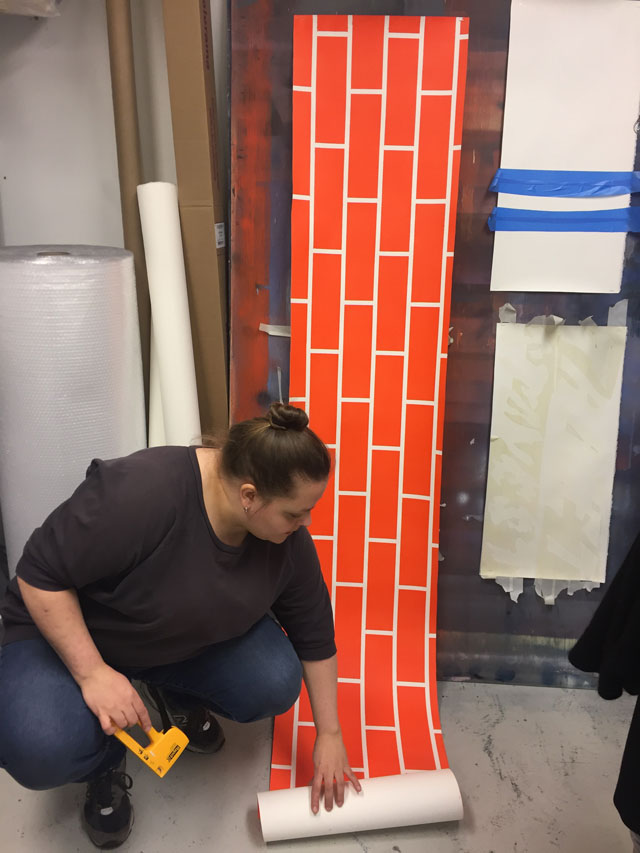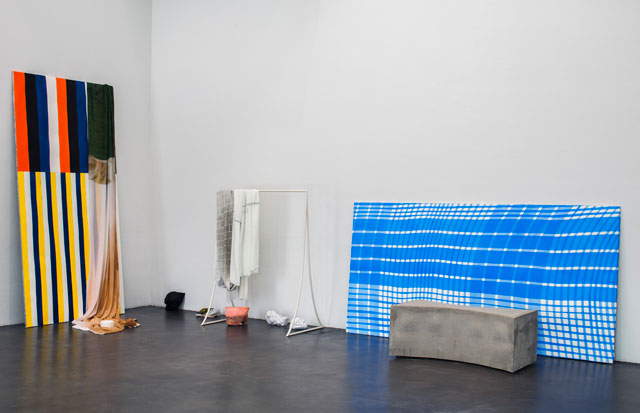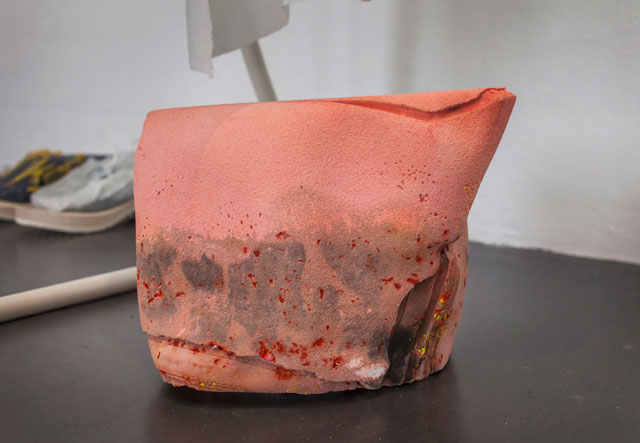
by KRISTIAN VISTRUP MADSEN
The Finnish artist Maija Luutonen was born in 1978 and graduated from the Finnish Academy of Fine Arts in 2006. She has exhibited in solo and group shows in her home country and in the Baltic and Nordic countries and, in 2012, was awarded the Ducat Prize by the Finnish Art Society. She is the inaugural recipient of the Kiasma Commission by Kordelin, a partnership between the Alfred Kordelin Foundation and Helsinki’s Kiasma Museum of Contemporary Art, the aim of which is to promote contemporary work in Finland. The selected artist is supported by a solo exhbition at the Kiasma.
I meet Maija Luutonen during a busy week. It is the day before her opening at the Kiasma, Finland’s national gallery for contemporary art, and a horde of Finnish and international press have shown up for the occasion. It is not that Luutonen is uncomfortable, but I get the feeling that she is like a fish out of water – the museum is not quite the natural element for her, or her work.
In 2012, together with eight other artists, Luutonen founded the artist-run project space SIC in an old warehouse beside Helsinki’s industrial harbour. This redbrick structure was designed in the early-20th century by Lars Sonck, a renowned architect operating between the Finnish variant of Jugendstil and Nordic romanticism. With its remarkable pattern of small windows facing the port and high wood-beamed ceilings, it is not your average art gallery, but it is also a far cry from Kiasma’s white cube. Here, on several occasions, Luutonen has exhibited her work in a much looser format than that on view at Kiasma. At the exhibition Soon, in late 2016, for instance, her large airbrushed paintings, some still on the rolls of paper, were lightly attached to the walls and casually pinned to the floor with pedestrian objects.

Maija Luutonen. Patch, 2018. Installation view. Photograph: Finnish National Gallery / Petri Virtane.
The lightness of the composition complements the former storage space by implying a continuing process of making; the works are dynamic, can be rolled back up, moved around, kept for later. At Kiasma’s high-ceilinged Studio K, the intended effect is the same; three paintings are in a stack by the window, another half-concealed by fabric. But already, at the suggestion of the museum’s technicians, the loose sheets of paper have been fastened to aluminium frames to help durability. At the press viewing, Luutonen stresses that the assembled objects and pictures could be shown and arranged any which way, either as a whole or in parts. However, as is customary in collecting institutions, the original installation, as graced by the artist’s own hand, is inevitably and for ever the more privileged one. As such, Luutonen is an artist in battle between artistic poles – preservation and spontaneity, finite objects and playful experimentation, even community-building and the marketisation of the artist as individual creator.

Maija Luutonen in her studio, 2018. Photograph: Kristian Vistrup Madsen.
At Luutonen’s studio the next day, however, it is clear that we have left the battlefield. Here, a perfect hand-painted brick wall tumbles off a roll of paper, and sketches for larger works sprout from all the drawers. A two-metre tall outline of a pointed doorway on blue has the texture of soft fabric, while an earlier iteration is more reminiscent of clouds. A stack of books on the table reveals a source of inspiration to be Aldo Rossi’s postmodern trompe l’oeils. This makes sense. A fleshy beige wave is part-infograph, part characterised by what I spontaneously describe as “vulva vibes”. I don’t think Luutonen minds; this is the water in which she swims.
Kristian Vistrup Madsen: You are so popular in this city. Everyone I have met who has any connection to the Finnish art scene has spoken highly of you. As I understand it, you are very involved with the community here, both exhibiting and with SIC. Why did you decide to start that space?
Maija Luutonen: I’ve always been engaged in these kinds of collectives. Even when I was a student at the fine art academy, I took part in some artist-run spaces. I had a feeling that the art scene wasn’t quite what I wanted it to be. I wanted something different, something more, but got sick of waiting and simply had to do it myself. Of course, I am not alone. A lot of other people felt like this, too, so we decided to do something about it. Especially after graduating, it felt very pertinent to begin to collaborate. I had started working as an artist, but I wasn’t very happy about the way things were going in my practice. I’m self-critical, and definitely wasn’t my own favourite artist. To get out of this rut, I wanted to create discussion. Also, in order to create a meaningful context for myself to work in, I wanted other people to thrive. I don’t see myself as especially important. I feel I have things to say, but I also know that other people have things to say, too. I never felt I should be given more room than others.

Maija Luutonen. Patch, 2018. Installation view. Photograph: Finnish National Gallery / Petri Virtane.
KM: I sometimes see it as a shame when people think that way. This may be a crude analysis, but you know who don’t tend to have such a mindset? Men. It is often the people who have good ideas who are busy giving other people space.
ML: I know very well. But I think there is plenty of space to be taken. I don’t think we are stepping on anybody’s toes, and I don’t mind the things that other people do. I think there is a lot to be done here, in terms of exhibitions, discussions and so on. In that sense, more can only be good. At SIC, we always wanted to have differences within our group, and have tried to open it up to different audiences, and also to invite artists from different backgrounds, or age groups.
KM: Would you say that there is a connection between this willingness to always open up and give space, and what we are seeing in your Kiasma exhibition, as well as previous ones, which also show a readiness to continuously renegotiate their own formats?
ML: Yes, and I’m becoming more aware of it as I talk about this new body of work. I’ve always had problems with monuments, and with notions of permanence in art – that you just put something up on a wall and it ends there. In the beginning, I think that’s what made me start working with paper, because it felt like a choice that would be against those things.

Maija Luutonen. Patch, 2018. Installation view. Photograph: Finnish National Gallery / Petri Virtane.
KM: As we were looking at your exhibition, [Kiasma’s director] Leevi Haapala pointed out that the paintings are arranged in such a way that you can’t see the monument of the man on the horse outside the window. Is that something you thought about?
ML: I’m not a big fan of him.
KM: Who is he?
ML: His name is Carl Gustaf Emil Mannerheim, and he was a military general who was very important in Finland’s war for independence in 1918 and in the Winter war of 1939-40. In a way, he is a symbol of the nation. I do like the statue, or rather, I like the pedestal: it’s too tall - if you imagine the square as it was before the museum opened in 1998, and you couldn’t have seen it from the windows, you wouldn’t have been able to see anything other than the underneath of the horse. Yesterday, we placed one more work in front of the windows – it was previously just two – and I like that you can’t see the statue, but you can still see the city. So, yeah, I’m not a big fan of monuments.
KM: You are right, the plinth is weird. The plinth is modernist, and then the sculpture is classical.
ML: Actually, it isn’t very old; it’s from 1960. It was already outdated when it was made.
KM: That makes it almost postmodern. On the subject of art history, I want to ask about your relationship to painting as a medium. Painting, as you say, is all about permanence.
ML: Painting gives me the possibility of working the way I want to. It makes it possible for me to be relaxed. It’s as simple as that. I don’t pretend that I can detach myself from all of the history – of course, I’m part of that discussion just by working in this way. And I am interested in that, but it’s not my main reason. If I make digital collages, for instance, which I sometimes do, it’s a totally different relation between me and the screen, as between me and my tools. With painting, it’s very difficult to be precise. There are a lot of mistakes involved, and a lot of coming to terms with the mistakes. I like those things.

Maija Luutonen. Patch, 2018. Installation view. Photograph: Finnish National Gallery / Petri Virtane.
KM: I wonder what it is about those things: imprecision, mistakes. This new suite of works is called Patch, inspired, you said, by the idea of “code patching”, tech-jargon for fixing a bug in computer software. In the analogue world of painting, it’s also about adding layers to something, painting over mistakes, but letting the patches show. This again, relates to this notion of always being in process.
ML: I don’t want to produce dead images, and if I don’t let an image have its own life, it dies. Every time I make another painting, I think it will be my last one, and I always think I’ll make something different afterwards. But I always end up painting again simply because I like it. I like being with the works that way. The fact that I let myself believe that I can always change everything and keep all the options open is what allows me to continue painting. This way, I never have to stop.

Maija Luutonen. Patch, 2018. Installation view. Photograph: Finnish National Gallery / Petri Virtane.
KM: I suppose, in this sense, each painting is always an instance on a continuum. That is also something that has been written about your work before. That it is about temporality, about time as a concept. How so?
ML: In a general way, I think that everything is in motion. This kind of logic: stone used to be liquid, and so this, too, is going to be dust at some point. With some of my works, I really have this in mind. That’s also why I find permanence and monuments a little bit ridiculous. And humans are ridiculous in this way: it’s difficult for us to think about time before we were born, much less about millions of years.
KM: Is that what is behind your interest in process? That you can see an expanse of time within it – works changing into different shapes and constellations?
ML: That’s one of the things. But I think that often I reduce so much that there is not enough material left for patching, so to speak. With this exhibition, I wanted to show things that I find embarrassing and I often leave out; things that are uncomfortable, silly or reveal too much, somehow. Like the concrete mould of the computer case, or the printed image of the noodles. Not reducing to a point where my point of departure becomes obscure, but precisely revealing it. So, yes, it’s about process, but it’s also about revealing.

Maija Luutonen. Patch, 2018 (detail). Installation view. Photograph: Finnish National Gallery / Petri Virtane.
KM: What is the significance of embarrassment?
ML: I don’t want to create interest in my work by way of being obscure. I want to create interest by being interesting.
KM: So it is about honesty?
ML: Nobody is ever honest.
KM: But at least honest about the fact that you can never be honest, then?
ML: [laughs] More honest than normal!
KM: It is so Scandinavian, I find, this kind of hypersincerity. Another thing that interests me about your work is weight v volume, or lightness v intensity. The paintings are very light, you can move them around, but then you have these heavier objects, too, like the concrete bench and the shoes. What are they doing there?
ML: I have always been interested in looking for things that are surprisingly light, or surprisingly heavy. For instance, you see something that looks like a stone, but it’s actually porous and super light. Or if you have a T-shirt and you wrap a heavy stone inside it, and someone lifts it up to find it’s really heavy. But also, quite simply, I use those things when I work. Because the paper has been rolled for so long, it doesn’t want to straighten, but I need it to do that. So I am always looking for things that are just right; not too heavy and not too light. I have canisters in my studio that are filled halfway with water, or are full, and I use those. Or I use shoes. That also looks nice because it’s as if somebody is standing on it.

Maija Luutonen. Patch, 2018 (detail). Installation view. Photograph: Finnish National Gallery / Petri Virtane.
KM: Another thing I wondered about was utility or functionality. For example, if someone else was to make a sculpture out of bronze, it is not heavy because it needs to be heavy, but because bronze is prestigious. But you make these things heavy because you need to pin the paper down. Also, some of the other objects you have made are useful, like the bench and the clothes hanger: why this functionality?
ML: I’m interested in the way people live with objects, and the way objects are in the world. Also in the difference between living with an art-object and living with an object-object that has some kind of use. How you can detect those things, and how they can be misleading, also. Some of the things I make look as if they are used for something, but then you find out it’s for nothing, or that it’s a replica. The round white objects, I got while in Japan. They use them when pickling vegetables at home, but I use them in my studio for weighing down the paper. The one that’s in the exhibition, however, is a copy that I made myself, like a prop in a theatre. I wonder what that means; if it matters.
KM: In a certain sense, then, the display becomes a kind of staged process, or it highlights the way in which an exhibition is always a performance. Is the faux-functionality of the objects also, in line with your anti-monument thinking, a kind of modesty?
ML: Probably, yeah. I think I should really think about this modesty more.
KM: It could also be read as courageous to give space, and not to demand control over your work.
ML: I’m hoping for that. But I think it was a good point you made regarding men and women and taking up space. That is how it often goes. It’s just something that is so built-in that it’s difficult to analyse yourself. And even if we are quite equal gender-wise in Finland, it’s still unequal in the art world. There are more men in the museum collections and presenting solo exhibitions, and more is paid for men’s work than women’s. It’s beginning to change a bit, so there are more women in the academy, and more are making sculpture. I also think there are now more women than men in the group of artists at SIC.
KM: It seems as if you as a group have this nurturing role in the art scene. Not just nurturing your own practices, but a community of people who then have somewhere to go. You recently found out that you have to leave SIC’s exhibition space after six years. Do you see your work as a group continuing, or changing shape?
ML: We worked for one year without a space before, so we have experience in that. A few years ago, we started rethinking our situation anyway, wondering if we should find a different kind of space. So, yes, I think we can do other things as well, and we will, I’m sure.